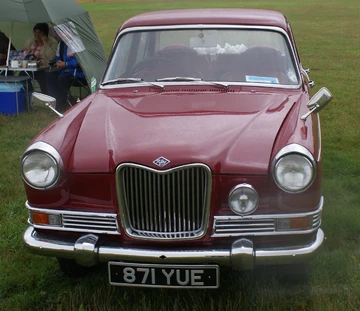
Riley 4/68
The Riley 4/68 and 4/72 are cars produced by BMC from 1959 through the 1960s. They are related to the Pinin Farina-designed Austin A55 Cambridge, MG Magnette Mk. III, Morris Oxford V, and Wolseley 15/60, sharing the MG's rear styling and engine (with a milder cam).
Another related car was the 1959–1965 Siam Di Tella of Argentina, they were externally identical to the Riley 4/72 family. There was the sedan Di Tella 1500, the station wagon Di Tella Traveller and the pick-up (never produced in England) Di Tella Argenta. All of them were fitted with the 1498cc engine and 3 speed manual column change. The MG Magnette Mark IV was also produced but with the nomenclature Siam Magnette 1622, it featured the larger 1.6L 1622 cc motor, hence the name.
Riley 4/68[]
Launched in April the 4/Sixty-Eight was the last of the five B series BMC Pininfarina cars to be released. The Riley used the twin-carburettor B-Series straight-4 engine in the form already familiar to drivers of the MG Magnette III, producing 64 bhp (48 kW). This was 6 hp (4.5 kW) more than the similar Wolseley 15/60.
From the outside the car was distinguished from its siblings by a Riley grille on the front and (apart from the MG with which it shared its tail treatment) slightly less acute tail fins at the back. Inside the facia was relatively well equipped: this was the only one of the five cars to come with a rev counter as standard equipment.
A car was tested by the British magazine The Motor in 1959 and had a top speed of 88.2 mph (141.9 km/h) and could accelerate from 0-60 mph (97 km/h) in 18.8 seconds. A fuel consumption of 27.3 miles per imperial gallon (10.3 L/100 km; 22.7 mpg-US) was recorded. The test car cost £1028 including taxes.
Riley 4/72[]
Just before the 1961 Motor Show, in October, the car became the 4/Seventy-Two. Closely related again was the 16/60 update to the Wolseley car. The engine was now 1.6 L (1622 cc), and Riley again got the twin-carb version with 68 hp (51 kW). It also used an improved suspension with anti-roll bars. The wheelbase was 1 in (25.4 mm) longer, through the moving of the back axle rearwards, and the front track was increased by 2 inches (5 cm). These modifications to the wheel locations were made at the same time to all the BMC Farina saloons, and were seen as an answer to criticism of the indifferent road holding of the 1959 cars. Borg Warner automatic transmission became an option in the Riley at the same time, making the Riley the first mass-produced car in Europe to adopt the Borg-Warner 35 system following Borg-Warner's establishment of a plant at Letchworth to produce a transmission package that ten years earlier had been developed for US applications.
Further modifications to the suspension a year later included 'recambering the rear springs' to improve ride and roadholding, but from the outside there was little to distinguish the later Rileys from the models as they had appeared in 1959, and the car continued very little changed until its withdrawal in 1969.
The 4/72's main competitor, appearing in 1963, was the Humber Sceptre from the Rootes Group - with a 85hp engine, 4 speed manual or 3 speed automatic (post 1965) and a more modern interior it thoroughly trounced the 4/72 in reviews of the period.
When an automatic 4/72 was tested by The Motor magazine in 1962 they recorded a top speed of 81.3 mph (130.8 km/h), acceleration from 0-60 mph (97 km/h) in 20.6 seconds and a fuel consumption of 26.5 miles per imperial gallon (10.7 L/100 km; 22.1 mpg-US). The test car cost £1186 including taxes. The manual car was £1087.
This model was also sold as the Riley Comet in Austria.


